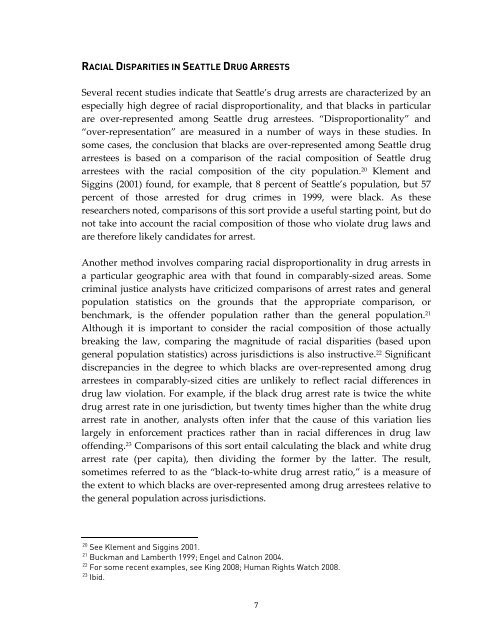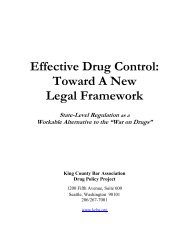RACE AND THE ENFORCEMENT OF DRUG DELIVERY LAWS IN ...
RACE AND THE ENFORCEMENT OF DRUG DELIVERY LAWS IN ...
RACE AND THE ENFORCEMENT OF DRUG DELIVERY LAWS IN ...
Create successful ePaper yourself
Turn your PDF publications into a flip-book with our unique Google optimized e-Paper software.
RACIAL DISPARITIES <strong>IN</strong> SEATTLE <strong>DRUG</strong> ARRESTS<br />
Several recent studies indicate that Seattle’s drug arrests are characterized by an<br />
especially high degree of racial disproportionality, and that blacks in particular<br />
are over-represented among Seattle drug arrestees. “Disproportionality” and<br />
“over-representation” are measured in a number of ways in these studies. In<br />
some cases, the conclusion that blacks are over-represented among Seattle drug<br />
arrestees is based on a comparison of the racial composition of Seattle drug<br />
arrestees with the racial composition of the city population. 20 Klement and<br />
Siggins (2001) found, for example, that 8 percent of Seattle’s population, but 57<br />
percent of those arrested for drug crimes in 1999, were black. As these<br />
researchers noted, comparisons of this sort provide a useful starting point, but do<br />
not take into account the racial composition of those who violate drug laws and<br />
are therefore likely candidates for arrest.<br />
Another method involves comparing racial disproportionality in drug arrests in<br />
a particular geographic area with that found in comparably-sized areas. Some<br />
criminal justice analysts have criticized comparisons of arrest rates and general<br />
population statistics on the grounds that the appropriate comparison, or<br />
benchmark, is the offender population rather than the general population. 21<br />
Although it is important to consider the racial composition of those actually<br />
breaking the law, comparing the magnitude of racial disparities (based upon<br />
general population statistics) across jurisdictions is also instructive. 22 Significant<br />
discrepancies in the degree to which blacks are over-represented among drug<br />
arrestees in comparably-sized cities are unlikely to reflect racial differences in<br />
drug law violation. For example, if the black drug arrest rate is twice the white<br />
drug arrest rate in one jurisdiction, but twenty times higher than the white drug<br />
arrest rate in another, analysts often infer that the cause of this variation lies<br />
largely in enforcement practices rather than in racial differences in drug law<br />
offending. 23 Comparisons of this sort entail calculating the black and white drug<br />
arrest rate (per capita), then dividing the former by the latter. The result,<br />
sometimes referred to as the “black-to-white drug arrest ratio,” is a measure of<br />
the extent to which blacks are over-represented among drug arrestees relative to<br />
the general population across jurisdictions.<br />
20 See Klement and Siggins 2001.<br />
21<br />
Buckman and Lamberth 1999; Engel and Calnon 2004.<br />
22 For some recent examples, see King 2008; Human Rights Watch 2008.<br />
23<br />
Ibid.<br />
7

















